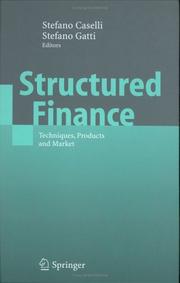| Listing 1 - 9 of 9 |
Sort by
|

ISBN: 9786611059392 9780080553344 0123736994 1281059390 0080553346 Year: 2008 Publisher: London Elsevier/Academic Press
Abstract | Keywords | Export | Availability | Bookmark
 Loading...
Loading...Choose an application
- Reference Manager
- EndNote
- RefWorks (Direct export to RefWorks)
Project finance is a fast-growing area of capital investment for major infrastructure and other large projects. Financing such projects as EuroDisney, airports, highways, tunnels, schools, hospitals, and other large projects presents a complex and interesting challenge that the specialty of project finance takes on wholeheartedly, combining financial engineering with legal and contractual expertise to develop various financing options. In this book, Stefano Gatti of Bocconi University describes the theory that underpins this cutting-edge industry, and then provides illustrations and examples
Public works --- -Construction industry --- -332.6 --- Building industry --- Home building industry --- Building --- Public works projects --- Buildings --- Construction projects --- Civil engineering --- Finance. --- Capital investments. --- E-books --- Engineering --- Industrial Engineering --- Construction industry
Book
ISBN: 0128114029 0128114010 Year: 2018 Publisher: London : Academic Press,
Abstract | Keywords | Export | Availability | Bookmark
 Loading...
Loading...Choose an application
- Reference Manager
- EndNote
- RefWorks (Direct export to RefWorks)
Public works --- Construction industry. --- Finance. --- Building industry --- Home building industry --- Building
Book
ISBN: 032398360X 9780323983730 0323983731 9780323983600 Year: 2024 Publisher: Academic Press
Abstract | Keywords | Export | Availability | Bookmark
 Loading...
Loading...Choose an application
- Reference Manager
- EndNote
- RefWorks (Direct export to RefWorks)
Project Finance in Theory and Practice: Designing, Structuring, and Financing Private and Public Projects, Fourth Edition provides essential, core coverage of project finance, offering new insights into Sharia-compliant instruments and a comprehensive overview of the current state of international regulation of banking post financial crisis. This updated edition includes new case studies and topics related to country risk, along with insights from project finance experts who share their specialized knowledge on legal issues and the role of advisors in project finance details. The book will be useful for readers at all levels of education and experience who want to learn how to succeed in project finance.
Entrepreneurship --- Investments --- New Business Enterprises --- Finance, Public --- Business Enterprises --- Business & Economics --- Public works --- Construction industry --- Finance. --- Capital investments.
Multi
ISBN: 9780124157538 012415753X 9780123919465 0123919460 Year: 2012 Publisher: Waltham, MA : Academic,
Abstract | Keywords | Export | Availability | Bookmark
 Loading...
Loading...Choose an application
- Reference Manager
- EndNote
- RefWorks (Direct export to RefWorks)
This book presents comprehensive coverage of project finance in Europe and North America. The Second Edition features two new case studies, all new pedagogical supplements including end-of-chapter questions and answers, and insights into the recent market downturn. The author provides a complete description of the ways a project finance deal can be organized-from industrial, legal, and financial standpoints-and the alternatives available for funding it. After reviewing recent advances in project finance theory, he provides illustrations and case studies. At key points Gatti brings in oth
Construction industry --- Public works --- Capital investments --- Finance --- Finance. --- Capital investments. --- Engineering --- General and Others

ISBN: 1280262559 9786610262557 3540272208 3540227989 Year: 2005 Publisher: Berlin ; London : Springer,
Abstract | Keywords | Export | Availability | Bookmark
 Loading...
Loading...Choose an application
- Reference Manager
- EndNote
- RefWorks (Direct export to RefWorks)
1 2 Laurent Huck and Sergio Trezzi During the last 5 years the asset management industry has been constantly invested by events which have required top management of major com- nies to rethink their business model, while preserving their company’s mission. From the Internet bubble easy growth model to a strong cost control - vironment in 2000-2003, many financial institutions have undertaken structural changes in order to reap the opportunities offered by the “new” market. Hints of globalization have actually been around for several decades, even though they made only a modest impact; however, the availability of global capital and advances in communication technology have emp- sized the process of internationalization and the tools available to connect and integrate business activities to answer to more complex needs of c- ents. Moreover, the financial scandals and the review of mutual fund trade activity in the US by the Attorney General Elliot Spitzer have highlighted the importance to focus all efforts on renewing the confidence of prof- sional investors and their clients who have entrusted their capital to asset managers. Therefore, there is a growing need in the market to reinforce the concept of “Shared Positive Values” among the entire industry and among its stakeholders.
Family-owned business enterprises --- Business enterprises --- Finance. --- Business finance --- Business financial management --- Financial analysis of business enterprises --- Financial management, Business --- Financial management of business enterprises --- Financial planning of business enterprises --- Managerial finance --- Business enterprises, Family-owned --- Family business --- Family businesses --- Family enterprises --- Family firms --- Entrepreneurship. --- Tax accounting. --- Finance, general. --- Business Taxation/Tax Law. --- Taxation --- Finance, Public --- Entrepreneur --- Intrapreneur --- Capitalism --- Business incubators --- Funding --- Funds --- Economics --- Currency question --- Accounting --- Tax laws. --- Tax laws --- Tax legislation --- Tax regulations --- Law

ISBN: 3540281398 3540253114 364206454X Year: 2005 Publisher: Berlin, Heidelberg : Springer Berlin Heidelberg : Imprint: Springer,
Abstract | Keywords | Export | Availability | Bookmark
 Loading...
Loading...Choose an application
- Reference Manager
- EndNote
- RefWorks (Direct export to RefWorks)
In recent years, financial engineering has developed new ways of financing deals based primarily on the capacity of the operations to generate sufficient cash for the repayment of loans or bonds. The business of structured finance has then become an interesting business area for non-financial companies, investment and commercial banks and consultants. In terms of volumes, it shows figures easily comparable to other, more traditional, sources of funding. This book provides the reader with an analysis of the characteristics of structured finance deals – asset-backed securitization, project finance, structured leasing and leveraged acquisitions – together with updated data on the current state of the international financial markets for these operations.
Asset-backed financing. --- International finance. --- International monetary system --- International money --- Finance --- International economic relations --- Asset-backed securities --- Asset-based financing --- Asset securitization --- Securitization, Asset --- Corporations --- Covered bonds --- Public finance. --- Finance. --- Commercial law. --- Management. --- Public Economics. --- Finance, general. --- Commercial Law. --- Administration --- Industrial relations --- Organization --- Business --- Business law --- Commerce --- Law, Commercial --- Mercantile law --- Law --- Law merchant --- Maritime law --- Funding --- Funds --- Economics --- Currency question --- Cameralistics --- Public finance --- Law and legislation --- Asset-backed financing --- International finance --- 333.605 --- 333.745 --- AA / International- internationaal --- Nieuwe financiële instrumenten --- effectisering. Titrisatie --- Public finances --- Finance, Public.
Book
ISBN: 3319541242 3319541234 Year: 2017 Publisher: Cham : Springer International Publishing : Imprint: Springer,
Abstract | Keywords | Export | Availability | Bookmark
 Loading...
Loading...Choose an application
- Reference Manager
- EndNote
- RefWorks (Direct export to RefWorks)
This book, now in its second edition, provides an in-depth overview of all segments of the structured finance business, with particular reference to market trends, deal characteristics and deal structuring. The goal is to assist readers in gaining a clear understanding of the common features of structured finance transactions. The process of deal structuring for each type of transaction is carefully analyzed, with extensively updated chapters on asset securitization, project finance, structured leasing transactions and leveraged acquisitions. In the new edition, particular attention is paid to novel areas of intervention, such as public–private partnerships and non-performing loans in the resolution of bank restructuring. Although the subject of much criticism, structured finance, when used properly, offers an effective solution to the credit crunch that many European countries are suffering and is also a way to revive a single capital market for debt instruments. Readers will find this book to be an illuminating guide to the business and to the best market practices in organizing transactions. It will be of value for BSc and MSc finance students, professionals and consultants alike.
Finance. --- Business enterprises --- Corporations --- Bank marketing. --- Capital market. --- Macroeconomics. --- Financial Services. --- Business Finance. --- Macroeconomics/Monetary Economics//Financial Economics. --- Corporate Finance. --- Capital Markets. --- Economics --- Capital markets --- Market, Capital --- Finance --- Financial institutions --- Loans --- Money market --- Securities --- Crowding out (Economics) --- Efficient market theory --- Banks and banking --- Marketing of bank services --- Marketing of banking services --- Marketing --- Business finance --- Capitalization (Finance) --- Corporate finance --- Corporate financial management --- Corporation finance --- Financial analysis of corporations --- Financial management, Corporate --- Financial management of corporations --- Financial planning of corporations --- Managerial finance --- Going public (Securities) --- Business financial management --- Financial analysis of business enterprises --- Financial management, Business --- Financial management of business enterprises --- Financial planning of business enterprises --- Funding --- Funds --- Currency question --- Business enterprises-Finance. --- Corporations-Finance. --- Asset-backed financing. --- Asset-backed securities --- Asset-based financing --- Asset securitization --- Securitization, Asset --- Covered bonds --- Business enterprises—Finance. --- Corporations—Finance.
Book
ISBN: 3030446670 3030446662 Year: 2020 Publisher: Cham : Springer International Publishing : Imprint: Springer,
Abstract | Keywords | Export | Availability | Bookmark
 Loading...
Loading...Choose an application
- Reference Manager
- EndNote
- RefWorks (Direct export to RefWorks)
A number of dramatic changes are currently reshaping infrastructure, a sector that investors and asset managers have traditionally considered to be a safe harbor in the field of alternative investments. Understanding the future of infrastructure is indispensable to guaranteeing a sustainable future for our planet and the welfare of the world’s population, and enhancing our knowledge of this asset class is one important step we can take toward reaching this crucial goal. This book collects a series of contributions by a group of Bocconi University researchers under the Antin IP Associate Professorship in Infrastructure Finance, which cover the key megatrends that are expected to reshape the way we think about infrastructure, and the implications for infrastructure investors and asset managers. Its goal is to improve and disseminate the culture of infrastructure among academics, professionals and policymakers. The main focus is on Europe and the European Union, and specifically on three key sectors: power and energy, transportation infrastructure, and telecoms / ICT. .
Disruptive technologies. --- Disruptive innovations --- Technological innovations --- Capital investments. --- Management. --- Industrial management. --- Economic policy. --- Risk management. --- Investment Appraisal. --- Innovation/Technology Management. --- R & D/Technology Policy. --- Risk Management. --- Insurance --- Management --- Economic nationalism --- Economic planning --- National planning --- State planning --- Economics --- Planning --- National security --- Social policy --- Business administration --- Business enterprises --- Business management --- Corporate management --- Corporations --- Industrial administration --- Management, Industrial --- Rationalization of industry --- Scientific management --- Business --- Industrial organization --- Administration --- Industrial relations --- Organization --- Capital expenditures --- Capital improvements --- Capital spending --- Fixed asset expenditures --- Plant and equipment investments --- Plant investments --- Investments
Book
ISBN: 3031279182 3031279174 Year: 2023 Publisher: Cham : Springer Nature Switzerland : Imprint: Springer,
Abstract | Keywords | Export | Availability | Bookmark
 Loading...
Loading...Choose an application
- Reference Manager
- EndNote
- RefWorks (Direct export to RefWorks)
Under the pressure of climate and social changes, agriculture is called to play a fundamental role in the world food challenge of the next few decades. A severe reduction of arable land and water scarcity combined with a growing food demand, changes in the dietary preferences in many countries and, more recently, a growing threat to food security and logistics from supply chains interruptions and global trade fragmentation, all require the implementation of processes, techniques, and innovations able to increase productivity and make a better use of scarce resources. Against this backdrop, a growing number of investors and asset managers have started looking at agriculture as an interesting investment theme to exploit the long-term strategic opportunities emerging from technological innovation and social changes. The industry is undergoing a process of transformation driven, on the one hand, by the emergence of new data and technologies that promise enhancing process efficiency and improve yields and, on the other hand, by an increased attention on the GHG emissions of agricultural processes and the impact of farmland on climate change, water and land scarcity. All these factors call for a radical rethinking of many agriculture business models. This book provides a detailed overview and analysis of those new technologies with the greatest potential to disrupt agriculture products and processes by improving productivity and the management of food loss and waste, making a more efficient and sustainable use of resources and enhancing food security. Then, it discusses the implications for investors and asset managers, starting with an assessment of the status quo of agriculture investing and providing a thorough description of the agriculture asset class with an emphasis on its distinctive characteristics and the innovations in the technological processes used in agriculture and farming with the greatest potential to obtain long-term sustainable returns.
Agriculture—Economic aspects. --- Valuation. --- Industrial management—Environmental aspects. --- Industries. --- Agricultural Economics. --- Investment Appraisal. --- Corporate Environmental Management. --- Industrial production --- Industries, Primitive --- Industry --- Economics --- Appraisal --- Capitalization (Finance) --- Economic valuation --- Property --- Accounting --- Valuation
| Listing 1 - 9 of 9 |
Sort by
|

 Search
Search Feedback
Feedback About UniCat
About UniCat  Help
Help News
News